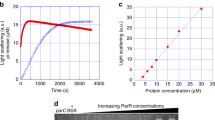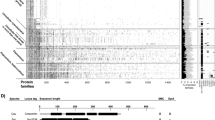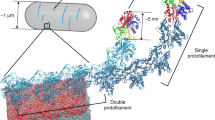Abstract
Filament-forming cytoskeletal proteins are essential for the structure and organization of all cells. Bacterial homologues of the major eukaryotic cytoskeletal families have now been discovered, but studies suggest that yet more remain to be identified. We demonstrate that the metabolic enzyme CTP synthase (CtpS) forms filaments in Caulobacter crescentus. CtpS is bifunctional, as the filaments it forms regulate the curvature of C. crescentus cells independently of its catalytic function. The morphogenic role of CtpS requires its functional interaction with the intermediate filament, crescentin (CreS). Interestingly, the Escherichia coli CtpS homologue also forms filaments both in vivo and in vitro, suggesting that CtpS polymerization may be widely conserved. E. coli CtpS can replace the enzymatic and morphogenic functions of C. crescentus CtpS, indicating that C. crescentus has adapted a conserved filament-forming protein for a secondary role. These results implicate CtpS as a novel bifunctional member of the bacterial cytoskeleton and suggest that localization and polymerization may be important properties of metabolic enzymes.
This is a preview of subscription content, access via your institution
Access options
Subscribe to this journal
Receive 12 print issues and online access
$209.00 per year
only $17.42 per issue
Buy this article
- Purchase on Springer Link
- Instant access to full article PDF
Prices may be subject to local taxes which are calculated during checkout





Similar content being viewed by others
References
Bi, E. F. & Lutkenhaus, J. FtsZ ring structure associated with division in Escherichia coli. Nature 354, 161–164 (1991).
Lowe, J. & Amos, L. A. Crystal structure of the bacterial cell-division protein FtsZ. Nature 391, 203–206 (1998).
Jones, L. J., Carballido-Lopez, R. & Errington, J. Control of cell shape in bacteria: helical, actin-like filaments in Bacillus subtilis. Cell 104, 913–922 (2001).
Ausmees, N., Kuhn, J. R. & Jacobs-Wagner, C. The bacterial cytoskeleton: an intermediate filament-like function in cell shape. Cell 115, 705–713 (2003).
Briegel, A. et al. Multiple large filament bundles observed in Caulobacter crescentus by electron cryotomography. Mol. Microbiol. 62, 5–14 (2006).
Li, Z. & Jensen, G. J. Electron cryotomography: a new view into microbial ultrastructure. Curr. Opin. Microbiol. 12, 333–340 (2009).
Li, Z., Trimble, M. J., Brun, Y. V. & Jensen, G. J. The structure of FtsZ filaments in vivo suggests a force-generating role in cell division. EMBO J. 26, 4694–4708 (2007).
Werner, J. N. et al. Quantitative genome-scale analysis of protein localization in an asymmetric bacterium. Proc. Natl Acad. Sci. USA 106, 7858–7863 (2009).
Long, C. W., Levitzki, A. & Koshland, D. E., Jr. The subunit structure and subunit interactions of cytidine triphosphate synthetase. J. Biol. Chem. 245, 80–87 (1970).
Briegel, A. et al. Location and architecture of the Caulobacter crescentus chemoreceptor array. Mol. Microbiol. 69, 30–41 (2008).
Ma, X., Ehrhardt, D. W. & Margolin, W. Colocalization of cell division proteins FtsZ and FtsA to cytoskeletal structures in living Escherichia coli cells by using green fluorescent protein. Proc. Natl Acad. Sci. USA 93, 12998–13003 (1996).
Gitai, Z., Dye, N. & Shapiro, L. An actin-like gene can determine cell polarity in bacteria. Proc. Natl Acad. Sci. USA 101, 8643–8648 (2004).
Hartman, S. C. The interaction of 6-diazo-5-oxo-L-norleucine with phosphoribosyl pyrophosphate amidotransferase. J. Biol. Chem. 238, 3036–3047 (1963).
Karimova, G., Pidoux, J., Ullmann, A. & Ladant, D. A bacterial two-hybrid system based on a reconstituted signal transduction pathway. Proc. Natl Acad. Sci. USA 95, 5752–5756 (1998).
Srinivasan, R., Mishra, M., Murata-Hori, M. & Balasubramanian, M. K. Filament formation of the Escherichia coli actin-related protein, MreB, in fission yeast. Curr. Biol. 17, 266–272 (2007).
Srinivasan, R., Mishra, M., Wu, L., Yin, Z. & Balasubramanian, M. K. The bacterial cell division protein FtsZ assembles into cytoplasmic rings in fission yeast. Genes Dev. 22, 1741–1746 (2008).
Levitzki, A. & Koshland, D. E., Jr. Cytidine triphosphate synthetase. Covalent intermediates and mechanisms of action. Biochemistry 10, 3365–3371 (1971).
Endrizzi, J. A., Kim, H., Anderson, P. M. & Baldwin, E. P. Crystal structure of Escherichia coli cytidine triphosphate synthetase, a nucleotide-regulated glutamine amidotransferase/ATP-dependent amidoligase fusion protein and homologue of anticancer and antiparasitic drug targets. Biochemistry 43, 6447–6463 (2004).
Lunn, F. A., Macleod, T. J. & Bearne, S. L. Mutational analysis of conserved glycine residues 142, 143 and 146 reveals Gly(142) is critical for tetramerization of CTP synthase from Escherichia coli. Biochem. J. 412, 113–121 (2008).
Paluh, J. L., Zalkin, H., Betsch, D. & Weith, H. L. Study of anthranilate synthase function by replacement of cysteine 84 using site-directed mutagenesis. J. Biol. Chem. 260, 1889–1894 (1985).
Charbon, G., Cabeen, M. T. & Jacobs-Wagner, C. Bacterial intermediate filaments: in vivo assembly, organization, and dynamics of crescentin. Genes Dev. 23, 1131–1144 (2009).
Cabeen, M. T. et al. Bacterial cell curvature through mechanical control of cell growth. EMBO J. 28, 1208–1219 (2009).
Kleinschmidt, A. K., Moss, J. & Lane, D. M. Acetyl coenzyme A carboxylase: filamentous nat of the animal enzymes. Science 166, 1276–1278 (1969).
Carrey, E. A. et al. Detection and location of the enzymes of de novo pyrimidine biosynthesis in mammalian spermatozoa. Reproduction 123, 757–768 (2002).
Zigler, J. S., Jr. & Rao, P. V. Enzyme/crystallins and extremely high pyridine nucleotide levels in the eye lens. FASEB J. 5, 223–225 (1991).
Bork, P., Sander, C. & Valencia, A. An ATPase domain common to prokaryotic cell cycle proteins, sugar kinases, actin and hsp70 heat shock proteins. Proc. Natl Acad. Sci. USA 89, 7290–7294 (1992).
Evinger, M. & Agabian, N. Envelope-associated nucleoid from Caulobacter crescentus stalked and swarmer cells. J. Bacteriol. 132, 294–301 (1977).
Pinter, S. F., Aubert, S. D. & Zakian, V. A. The Schizosaccharomyces pombe Pfh1p DNA helicase is essential for the maintenance of nuclear and mitochondrial DNA. Mol. Cell Biol. 28, 6594–6608 (2008).
Ely, B. Genetics of Caulobacter crescentus. Methods Enzymol. 204, 372–384 (1991).
Ellgaard, A. K., Mullin, D. A. and Minnich, S. A. Plasmid transformation of Caulobacter crescentus using electroporation. Abstr. Annu. Meeting Am. Soc. Microbiol. 209, 208 (1989).
Meisenzahl, A. C., Shapiro, L. & Jenal, U. Isolation and characterization of a xylose-dependent promoter from Caulobacter crescentus. J. Bacteriol. 179, 592–600 (1997).
Iancu, C. V. et al. Electron cryotomography sample preparation using the Vitrobot. Nat. Protoc. 1, 2813–2819 (2007).
Tivol, W., Briegel, A. & Jensen, G. J. An improved cryogen for plunge freezing. Microsc. Micoanal. 14, 375–379 (2008).
Iancu, C. V. et al. A 'flip-flop' rotation stage for routine dual-axis electron cryotomography. J. Struct. Biol. 151, 288–297 (2005).
Zheng, Q. S., Braunfeld, M. B., Sedat, J. W. & Agard, D. A. An improved strategy for automated electron microscopic tomography. J. Struct. Biol. 147, 91–101 (2004).
Suloway, C. et al. Fully automated, sequential tilt-series acquisition with Leginon. J. Struct. Biol. 167, 11–18 (2009).
Mastronarde, D. N. Dual-axis tomography: an approach with alignment methods that preserve resolution. J. Struct. Biol. 120, 343–352 (1997).
Amat, F. et al. Markov random field based automatic image alignment for electron tomography. J. Struct. Biol. 161, 260–275 (2008).
Domian, I. J., Quon, K. C. & Shapiro, L. Cell type-specific phosphorylation and proteolysis of a transcriptional regulator controls the G1-to-S transition in a bacterial cell cycle. Cell 90, 415–424 (1997).
Simard, D., Hewitt, K. A., Lunn, F., Iyengar, A. & Bearne, S. L. Limited proteolysis of Escherichia coli cytidine 5′-triphosphate synthase. Identification of residues required for CTP formation and GTP-dependent activation of glutamine hydrolysis. Eur. J. Biochem. 270, 2195–2206 (2003).
Acknowledgements
We are grateful to B. Bassler, C. Murphy, E. Klein and K. Cowles for critical reading of the manuscript. We thank M. Cabeen, C. Jacobs-Wagner, J. Williamson, Alison Michaelis and other members of the Gitai lab for reagents and discussions. J.N.W. is supported by a postdoctoral fellowship from the National Institute of Allergy and Infectious Diseases (grant 1F32AI073043–01A1). A.B. and G.J.J. were supported in part by the National Institutes of Health (NIH) grant R01 AI067548, the Howard Hughes Medical Institute, and a gift to Caltech from the Gordon and Betty Moore Foundation. Z.G. is supported by funding from the U.S. Department of Energy Office of Science (Biological and Environmental Research; grant DE-FG02-05ER64136), NIH grant 1DP2OD004389-01, the Human Frontiers Science Program and the Beckman Foundation.
Author information
Authors and Affiliations
Contributions
M.J.I. performed all experiments except for the ECT and fLM-ECT experiments, which were performed by A.B. J.N.W. performed the initial screen that identified CtpS as a linearly localized protein. Experiments were conceived by M.J.I., A.B., G.J.J. and Z.G., and the manuscript was written by M.J.I. and Z.G. with significant input from A.B. and G.J.J.
Corresponding author
Ethics declarations
Competing interests
The authors declare no competing financial interests.
Supplementary information
Supplementary Information
Supplementary Information (PDF 1851 kb)
Rights and permissions
About this article
Cite this article
Ingerson-Mahar, M., Briegel, A., Werner, J. et al. The metabolic enzyme CTP synthase forms cytoskeletal filaments. Nat Cell Biol 12, 739–746 (2010). https://doi.org/10.1038/ncb2087
Received:
Accepted:
Published:
Issue Date:
DOI: https://doi.org/10.1038/ncb2087



